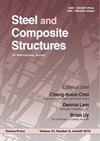Nonlinear dynamic analysis of soil nail walls considering different modeling approaches
IF 3.9
3区 工程技术
Q1 CONSTRUCTION & BUILDING TECHNOLOGY
引用次数: 1
Abstract
Soil nailing is one of the most common and important techniques to exchange conventional retaining systems for deep excavation. This approach contains a significant saving in cost and time of construction compared to conventional retaining systems. In this paper, an attempt has been made to evaluate the dynamical response of a deep vertical excavation on ground of 8 m height using soil nail wall. It has been tried to investigate the effects of different modeling approaches on the dynamic response of soil-nailed walls by considering the three behavioral methods; Mohr Coulomb (MC), hardening soil (HS) and hardening soil model with Small-Strain stiffness ensued from small strains (HSS). Nonlinear time history analysis has been implemented to compare the displacements under the sinus excitation with 0.5, 1, and 1.5 Hz with PGA= 0.3 g. Different points along the height of the wall are selected and considered. At the last part of this paper, incremental dynamic analysis (IDA) was implemented to the soil nail wall to consider the effect of the different earthquake records on the response of the wall. The IDA curve is also presented for the considered soil nail wall.考虑不同建模方法的土钉墙非线性动力分析
土钉支护是代替传统支护系统进行深基坑开挖的最常用、最重要的技术之一。与传统的支护系统相比,这种方法在成本和施工时间上都有显著的节省。本文尝试用土钉墙对8 m深基坑的动力响应进行评价。考虑三种行为方法,探讨了不同建模方法对土钉墙动力响应的影响;Mohr Coulomb (MC)、硬化土(HS)和小应变硬化土模型(HSS)。采用非线性时程分析方法,比较了在PGA= 0.3 g时,0.5、1和1.5 Hz的窦性激励下的位移。沿着墙的高度选择和考虑不同的点。最后对土钉墙进行了增量动力分析(IDA),考虑不同地震记录对土钉墙响应的影响。本文还给出了土钉墙的IDA曲线。
本文章由计算机程序翻译,如有差异,请以英文原文为准。
求助全文
约1分钟内获得全文
求助全文
来源期刊

Steel and Composite Structures
工程技术-材料科学:复合
CiteScore
8.50
自引率
19.60%
发文量
0
审稿时长
7.5 months
期刊介绍:
Steel & Composite Structures, An International Journal, provides and excellent publication channel which reports the up-to-date research developments in the steel structures and steel-concrete composite structures, and FRP plated structures from the international steel community. The research results reported in this journal address all the aspects of theoretical and experimental research, including Buckling/Stability, Fatigue/Fracture, Fire Performance, Connections, Frames/Bridges, Plates/Shells, Composite Structural Components, Hybrid Structures, Fabrication/Maintenance, Design Codes, Dynamics/Vibrations, Nonferrous Metal Structures, Non-metalic plates, Analytical Methods.
The Journal specially wishes to bridge the gap between the theoretical developments and practical applications for the benefits of both academic researchers and practicing engineers. In this light, contributions from the practicing engineers are especially welcome.
 求助内容:
求助内容: 应助结果提醒方式:
应助结果提醒方式:


